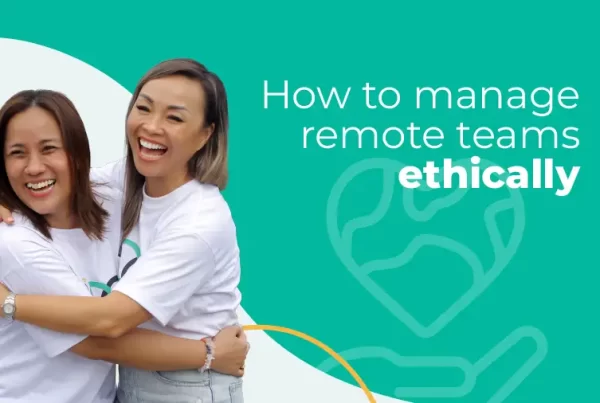Most employers, managers, and entrepreneurs hire Virtual Assistants to free up their time so they can focus on the more essential things. While that’s a crucial starting point, understanding how to train a Virtual Assistant is a common issue that many people face and doing it incorrectly will ultimately result in a waste of time and resources.
There are many areas in your business that involve repetitive work like data entry, research, email management, social media posting, responding to comments, and so on. These are common Virtual Assistant tasks, but over the years of working with Virtual Assistants, we know that training your remote staff effectively allows you to outsource much more than that.
So let’s talk about how you can train a Virtual Assistant into someone that is task-oriented to an active problem solver who can do more than type up transcriptions for your YouTube videos. Instead, imagine a Virtual Assistant that could also spot and address issues and make recommendations and potentially become the key to your business expansion.
Training your Virtual Assistant using levels
After working with hundreds of businesses that have successfully scaled their business after hiring Virtual Assistants, we’ve started to see a clear pattern. These businesses were willing to invest time in training their Virtual Assistants to do high-tier execution work through “levelling up” each time they nailed a set of tasks. By assigning tasks in levels, the Virtual Assistant eventually reached a stage where they were trusted to keep the business running while the business owner was away. That’s a level of trust that you’ll need to build over time.
This process takes a lot of work, patience, discipline, and guidance from the business owner’s end – but Outsourcing Angel is happy to hold your hand through the process too. We have monthly check-ins with our clients allowing them to:
Monthly check-ins
- 1-on-1 time with our Operations Manager to answer any questions and assist with problem solving
- SWOT analysis to identify any gaps in business operations and how we can help
- Share client resources such as checklists and templates that are useful to your business
- Recommendations on next steps in terms of setting up systems and process improvements
This is how you set the foundations for a long-term relationship with a Virtual Assistant that you can train through different levels of your business. To give you a better overview of what this looks like in the first 3-6 months with your Virtual Assistant, here’s something that might help:
Your first 3-6 months with your Virtual Assistant
Download our Infographic to give you an overview of what to expect in the initial months with your Virtual Assistant.
The two critical factors to successfully train a Virtual Assistant
Culture
A strong culture that enables resourcefulness, transparency, develops curiosity and rewards progress.
Processes
Processes that are well defined and documented to achieve an efficient workflow.
Building virtual skills starts with culture
Culture is defined as the collective behaviours of an organisation that greatly influences the way things get done in an organisation. It answers the primary question of “how do we get things done in this company?”
One study showed that up to 46% of job seekers cited company culture as an essential aspect of the company recruitment process. They wanted to know what culture they were getting into and see if it aligned with their values. Those who found the culture that fit theirs early on were more likely to stay in the company and help the business save countless hours and dollars from recruiting, hiring, and onboarding staff.
Before we even ask what skills a Virtual Assistant should have, we need to check if our company has the right culture with leaders who exemplify that culture too. So what kind of culture does a business need to promote resourcefulness?
Encourage your Virtual Assistant to find solutions to problems
The first step we took to build a resourceful culture was to promote our internal rule of “No Naked Questions.” This means, when anyone comes across a business problem, instead of presenting the problem, we must also come up with suggestions on how to fix/improve the issue so that the team can discuss the options together. This culture teaches Virtual Assistants to do their own research and take some thought into some ways that the team could resolve the issue.
No Naked Questions examples
| Instead of… | Try.. |
| This video isn’t getting many views | I noticed this video isn’t getting many views, perhaps we can try testing a new upload time or making the video shorter? |
| This link is no longer working | This link is no longer working, we should redirect it to this link instead. |
| This image is hard to read | This image is hard to read, I suggest we increase the font size. |
So if your virtual staff members come to you with a problem but don’t present a solution, be unwavering in the culture of letting them go back to the drawing board to think of a plan of action. Teach them to also present options (at least two or three) on how to achieve the solution.
Don’t be the main firefighter
Training your virtual staff to have resourcefulness doesn’t mean letting them off easy with a simple “status report” without a plan of action. Instead, Virtual Assistants should be trained to show they’re actively thinking about the solution or steps on how to get there.
We’ve taught our clients in Outsourcing Angel to take this approach too when fires arise in their businesses. The business owner or managers shouldn’t be the primary firefighters in the business. By training your Virtual Assistants to put out the smaller fires first, you’re setting the building blocks to give them confidence with assisting in bigger issues too so that you can eventually save yourself the trouble of thinking of solutions. Here are the key things you’ll need to do in order to set this up for your Virtual Assistant.
Include
Include your VA in the decision-making process when dealing with resolving issues/problems.
Feedback
When editing/evaluating your VA’s suggestions, give them your feedback as to what you like/don’t like and why
Reward
Don’t forget all the rewards from small “thank yous” to bigger gestures like pay bonuses, don’t let your VAs efforts go unnoticed!
Instill confidence in your Virtual Assistants
On many occasions, we’ve discovered that what holds Virtual Assistants back from finding solutions is a lack of self-confidence. They didn’t think they could find the solution even before they started looking for it!
However, usually the leader has agency over a staff member’s lack of self-confidence. Saying things like “I trust in your judgment” or “You’ve got this!” can make all the difference. Believing in your staff is a wonderful way to enable them to turn into resourceful problem-solvers that add value to others.
Tips on instilling confidence in your Virtual Staff
- Catch-up with your Virtual Assistant regularly and build on that relationship
- Get to know your Virtual Assistant personally, you can do this in the first or last 10 minutes of your work meetings to build on your friendship
- As the CEO or manager, you also have to own up to your mistakes too! Don’t pretend you’re perfect, nobody is
- Allow your Virtual Assistant to share their ideas and thank them for contributing these ideas, even if you’re not always able to implement them
- Discuss positive components of your Virtual Assistant’s work instead of only providing feedback when there’s something to change/edit
- Show that you trust your Virtual Assistant, even saying the words “I trust you!” can go a long way
Tools you’ll need to train your Virtual Assistant
With the culture now in place to enable resourceful staff, what you’ll need to do next is give them the tools to succeed and the knowledge to get the right solutions.
We suggest providing your Virtual Assistant with a guide that will serve as their standard operating procedure when troubleshooting. Here’s a straightforward process guide that we share with our clients that regularly help set their Virtual Assistants or teams up for success.
Virtual Assistant troubleshooting guide
- Go to YouTube or Google and type queries that will teach them how to fix issues.
- When they get stuck with Google or YouTube for ten minutes or more, visit the help or support areas to find a solution. Check the knowledge hub or chat with their tech support.
- If you can’t find an answer, get help from a colleague or approach one’s supervisor to see if he or she has a ready solution.
- While waiting for a response, park it for a later task and then move to the next task on the list. This step is vital so your staff don’t spend a large chunk of time on a problem. Sometimes, stepping away from the problem even provides the headspace to solve it.
Investing in Virtual Assistant skills training to brush up their problem-solving skills or equip them with specific technical knowledge can also go a long way. Say, for instance, you constantly have problems with your Shopify store. Allow your Virtual Assistant to look for good online courses on fixing common Shopify issues and buy that course for them. Investing in digital tools that can automate recurring problems also helps.
Finally, we highly encourage teams to set regular tactical meetings to revisit issues and debrief on things that went right and things to improve on so that Virtual Assistants can solve problems better in the future. This muscle combined with the above will produce the most conducive environment for resourcefulness and solution-oriented thinking in your team.
Closing thoughts on training your Virtual Assistant to become resourceful
Virtual assistant outsourcing is a strategy that could give you the needed boost to bring your business to the next level of growth and success. But in order for us to make that happen, we need to empower our team to make good decisions and operate at their absolute best. That entails trusting them and setting them up to become resourceful by teaching them to solve problems even before they reach you.
It’s common for business owners to have the “white-knight” syndrome that says that all things fall on us and that we have to be the hero every day. But having this ideology is not only unfair to you. It’s unfair to your team as well.
Given that you’re able to hire a highly skilled and dedicated Virtual Assistant, your staff will be more than ready and willing to prove their capability. So, teaching your staff to be independent means allowing them to operate as if the business was their own and removing ourselves from the mix so that we don’t become the bottleneck to our company and our Virtual Assistant or team’s growth and development.
Ready to hire a resourceful Virtual Assistant?
Book your 1-on-1 Discovery Call today to chat to our Outsourcing Specialist about what kind of Virtual Assistant you need for your business and we’ll find you a reliable and experienced VA




























































































































































